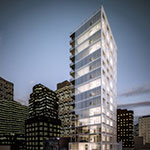What most people saw as an abandoned shopping mall covered in graffiti, Rackspace envisioned as a unique corporate headquarters—and today, its more than 3,800 employees work in cubicles where retailers such as JCPenney and Piercing Pagoda previously operated.

“It would have been easy for us to build a 500,000-square-foot office building or lease any number of properties, but we like to stay away from conventional, easy decisions,” says Jamie Kinch, director of real estate for Rackspace, a $1.5 billion cloud-computing company.
The business began out of a garage in the late 1990s, but by 2007, it had about 1,500 employees and was adding roughly 600 more each year. Because of this, it was already rapidly outgrowing the 200,000-square-foot office space in San Antonio that it had started leasing just two years earlier, so it needed a new facility—fast. And, at the same time, the struggling suburb of Windcrest, adjacent to the decrepit Windsor Park Mall, had been losing $100,000 in tax revenue annually since the mall closed in 2005. “Twenty years ago, Windcrest was the place to live around San Antonio, but over time, it really declined, and it was in desperate need of new energy,” Kinch says.

It was Rackspace chairman Graham Weston’s idea to buy the 1.2 million-square-foot mall, but pretty much everyone else thought he was crazy—and not just because of the property’s mammoth size. “Our employees were craving a corporate campus like those of Microsoft and Google, and the idea that they had left San Antonio to get impressive degrees, only to come back and sit in a cubicle at the mall they had worked at in high school, was not appealing,” Kinch says.
Weston was undeterred, however, and Rackspace signed a 30-year lease for the former mall. It turned out to be a win-win deal for everyone. In exchange for providing high-paying jobs in the area, Rackspace receives development grants from the State of Texas and favorable tax treatment on its property. And, since Rackspace’s lease began, Windcrest’s tax revenue has increased 10 percent every year—an outcome that Kinch says sits well with the company’s core values. “We want to be part of the community in which we’re based, and it felt like a good fit for us to have a positive impact,” he says.
There was initially some concern that Weston, who is known for his frugality, was simply seeking bargain-basement office space to save money, but that wasn’t the case. He envisioned a technology center comparable to Austin, Texas’s Silicon Hills, home to Dell, and he hired noted architect and urban planner Andrés Duany to develop a master plan.
The result is what must be one of the coolest office spaces in existence today. “There’s no forgetting that you’re in a mall,” Kinch says, but it may be the best mall ever. A soaring metallic half-arch over the entry greets employees, and inside they have conference rooms named after television game shows and breakfast cereals. There are also more unusual features, including a two-story slide, a chessboard the size of a basketball court, and a coffee shop.

“Because of how spread out the space is, navigation has been a consistent challenge, so we’ve created memorable sections and anchor features with each phase of development,” Kinch says. A recently opened phase, for example, used books as a theme, and it’s anchored by a breakout space called the Bookstore, which is designed to look like an old-fashioned shop, with low light, leather furniture, and materials repurposed from the old mall. Conference rooms are named after books, including the Alice in Wonderland conference room, which has strange-shaped chairs and other psychedelic features to create the sensation of being at the Mad Hatter’s tea party, and the Murder on the Orient Express conference room, which is designed like the inside of a train, with a whiteboard that looks like a window onto passing scenery.

The next phase, which is expected to open in June, will have a toy-store theme, and when employees enter, they’ll pass through the façade of an old-fashioned toy shop. Conference rooms will look like display windows, and they will be named after different toys such as the Slinky and Legos. “We’re constantly getting feedback from employees to ensure that we’re creating usable as well as cool spaces,” Kinch says.
“We figured we’d use a third of the [mall] space,” Kinch adds, “but it became apparent to us two years ago that we might run out.” So, soon, the company plans to break ground on a neighborhood plaza comprising the several acres around its new headquarters. The extra room will allow Rackspace to incorporate jogging trails, a performance venue, and other features, which will enhance the employee experience and revitalize the community that much more.


